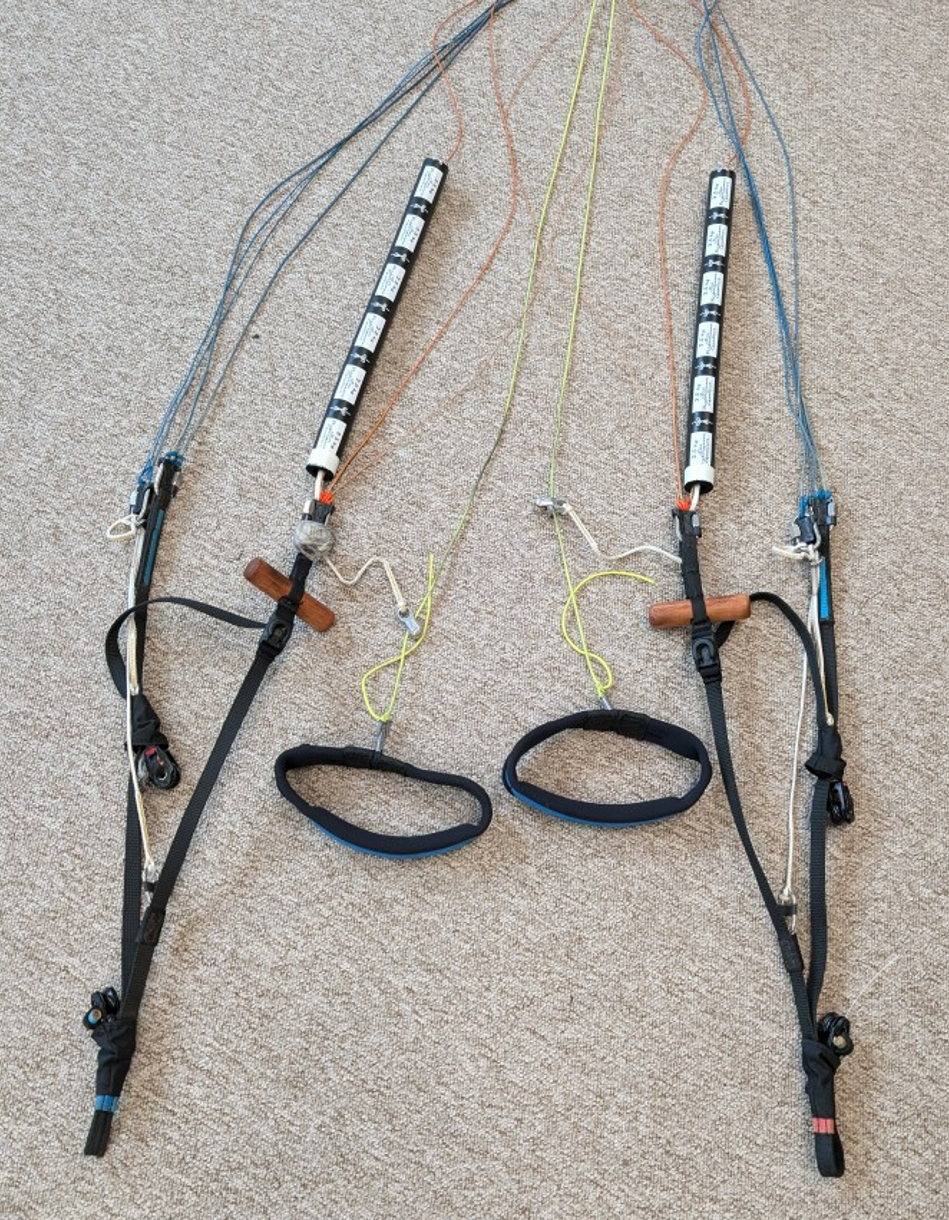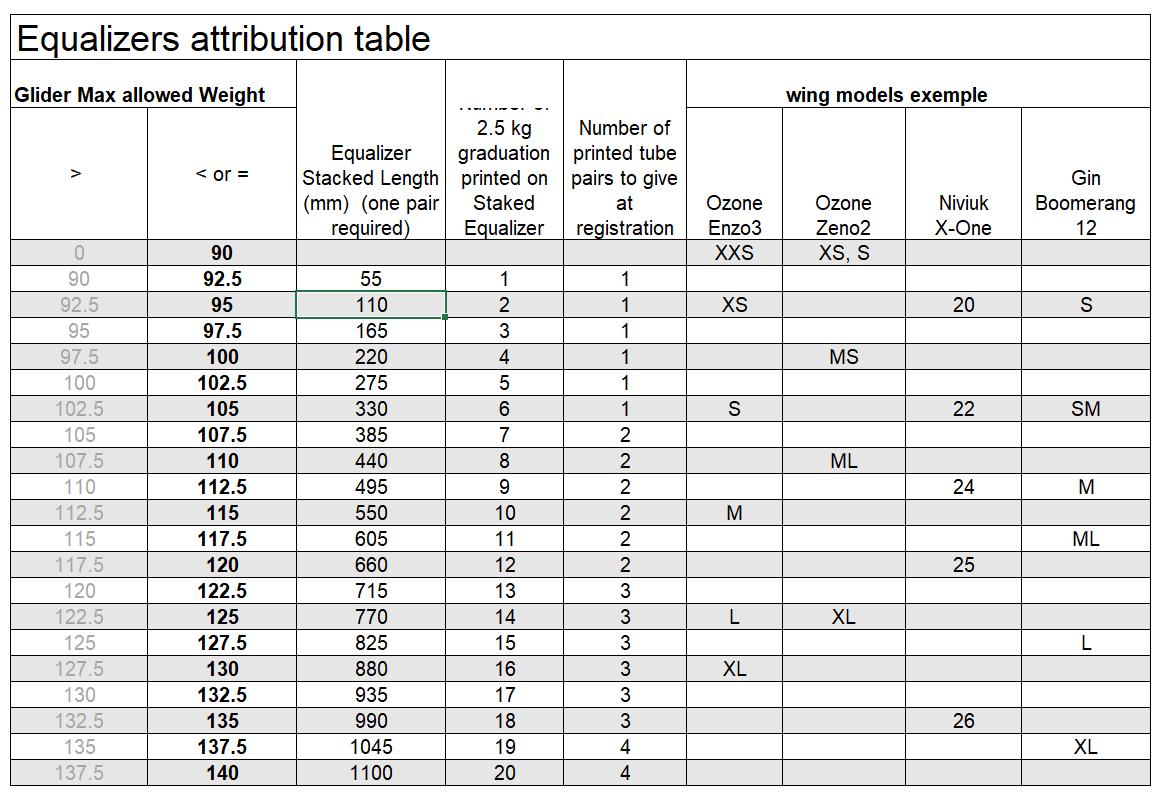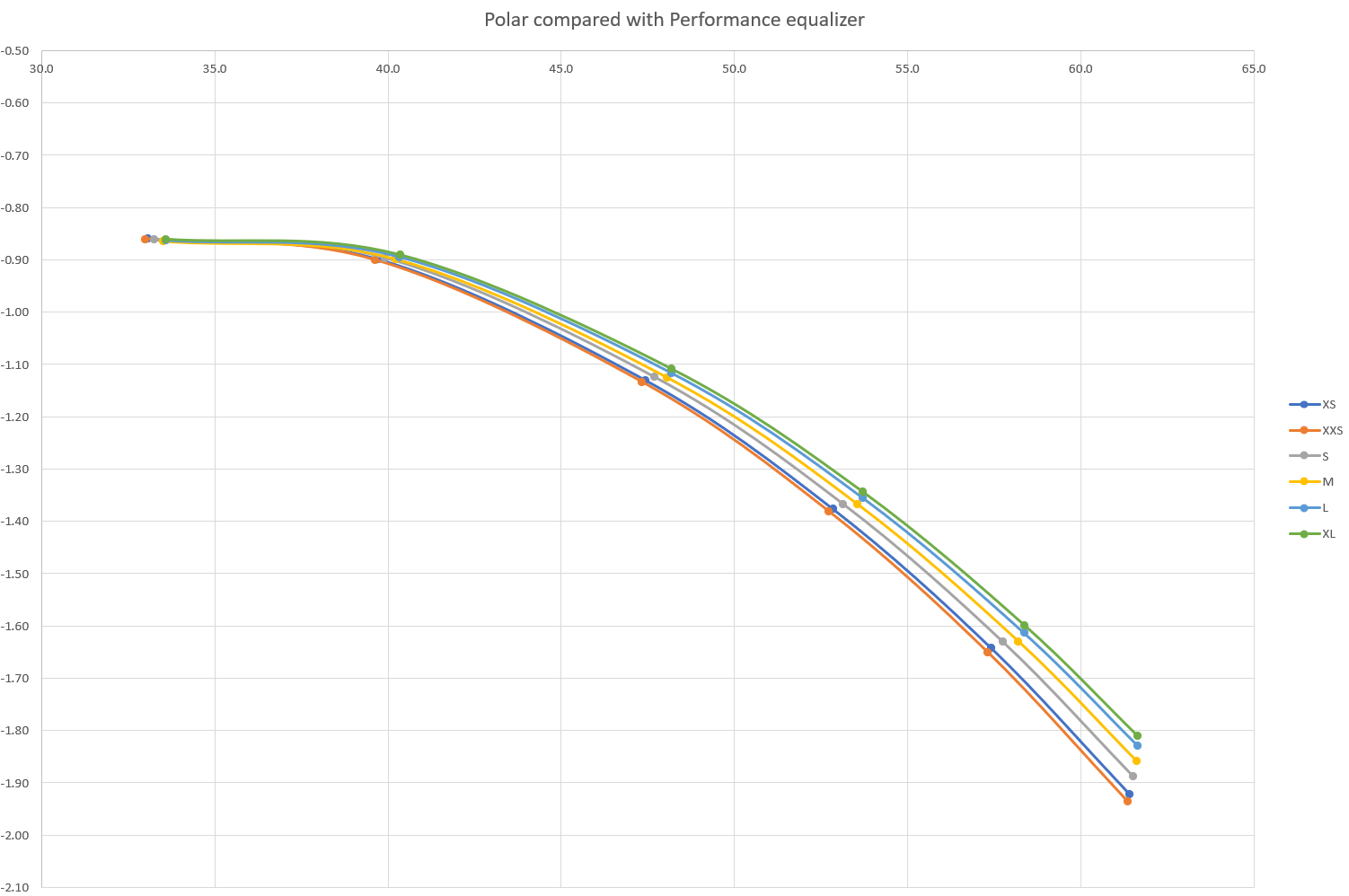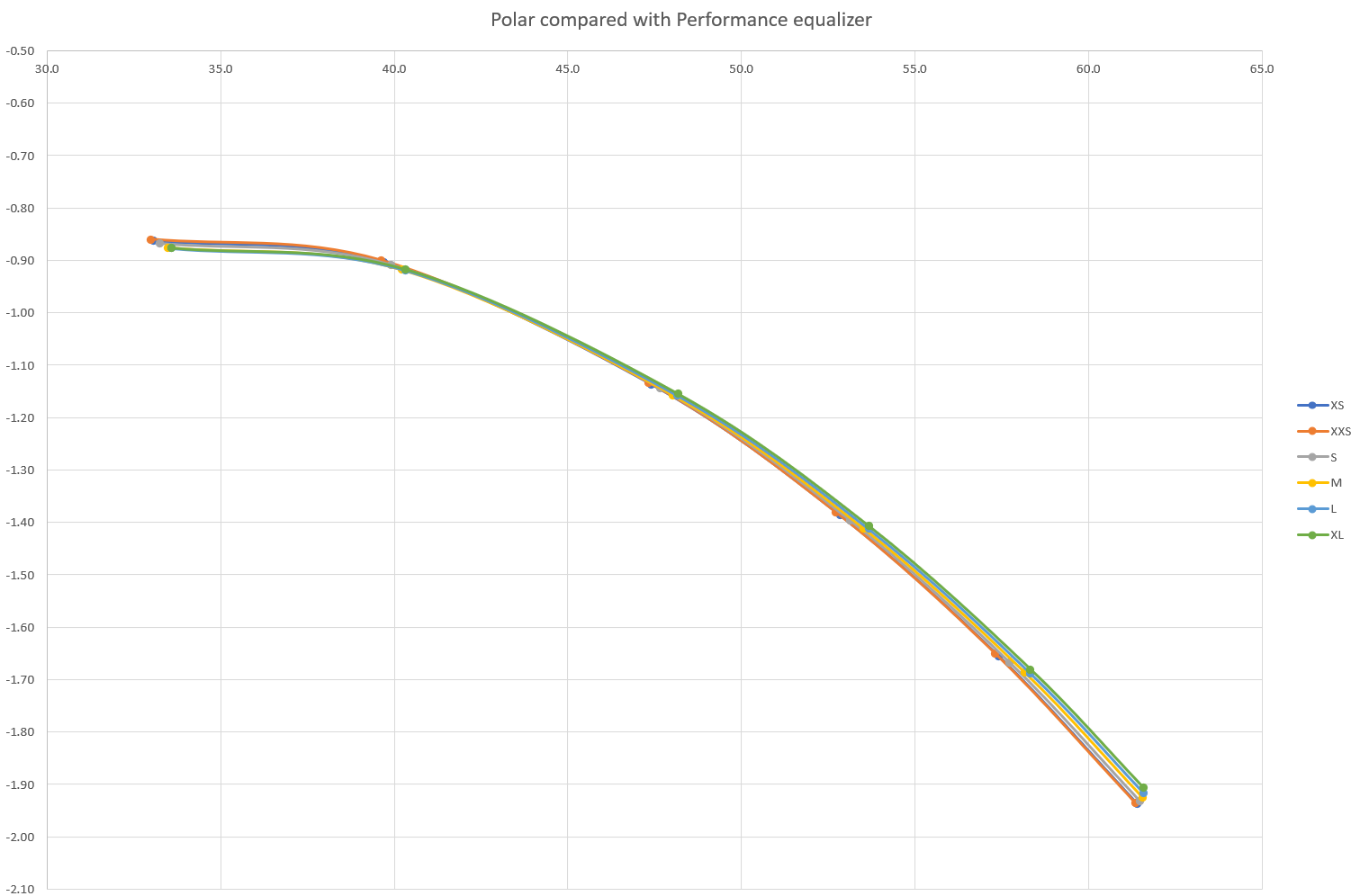This explanation about Equalizers is linked to Luc Armant Report "What we want" : Check it here !
Size Equalizers. Presentation Talk in Roldanillo 12/02/2025, PWCa superfinal
The issue:
A lot of pilots are carrying very heavy weights. A lot of bags total 40kg, while a leisure pilot usually flies with a 15kg bag. In effect a lot of pilots are flying 2 wing sizes above what they could be flying. The reason for that: Most pilots believe that they are performing better with a bigger size wing. Sometimes it’s the smallest sizes of competition wings which are missing or considered not safe enough.
However, this heavy equipment have multiple inconvenients:
1- pleasure. Carrying heavy bags is painful and removes a lot of the competing and travelling pleasure.
2- cost. Carrying heavy luggage costs for the pilots but it also cost for the organizers. Pilots often need to be retrieved in complicated remote places while they could easily reach some good road by foot if they were not having to carry heavy bags. In total, we are talking of at least one ton of excess weight for a whole competition compared to what would be possible without the incentive to fly heavy. Many competition pilots are flying with wings bigger than what leisure pilots use, and so they struggle to sell them second hand.
3- Positive feed-back loop (things getting worse): small sizes are not bought anymore in competition, so manufacturers don’t invest in optimising and improving small sizes, which makes the pilots even less wanting to buy them.
4- sport attractivity. Many pilots are put off by the perceived necessity to buy big size wings with heavy bags. A lot of them don’t want to buy another size of wing that they are currently doing for travelling and XC flights.
5- safety. Take-off and landing with such heavy weight is proved to be unsafe. We have all seen our friends breaking bones while they should not have with a normal equipment weight. But also flying with such a bigger weight gives more issues on arms and shoulders muscle and articulations for the lightest pilots.
It is believed that this issue is a reason for some pilots to stop competition, being injured or losing motivation. It is also believed that this issue is a loss of potential new pilots coming to the sport.
The difference in performance is not only perceived or believed, it’s also measured and calculated. The main reason for the difference of performance between sizes is the fact that harness drag does increase in a much smaller proportion than the increase of total weight. Yes, heavier pilots are often having bigger/longer arms than light pilots but it’s really marginal compared to the weight difference. The frontal area remains almost the same from an XXS to an XL pilot while the weight is going from 90kg to 130kg or more.
This scale effect, purely down to physics, is responsible for at least 70% of the performance difference between wing sizes. The rest remains in the line scaling, some Reynolds number effect, and some other unscaled parasite drags (risers, wing attachment tabs, etc.).
A practical solution:
Make an artificial but mandatory parasite drag device, called size Equalizers, in the form of a pair of foam tubes, that is proportional to wing size and will compensate for the difference of performance between sizes. Equalizers are installed to the more aft central line connected to the risers.
A pair of Equalizers mounted on an Enzo3 S (Size_Max_Weight = 105 kg).


Starting_wing_size: 90kg. Any size with max weight of 90kg or lower does not take any equalizers. This could be adapted with a smaller starting size if necessary, for example, 80kg.
Any size with bigger Size_Max_Weight than 90kg will be attributed a pair of equalizer according to the specification below:
Size_Max_Weight is rounded to the next multiple of 2.5kg. Exemple, if Size_Max_Weight is 112kg, Rounded_Size_Max_Weight = 112.5kg
Tube Diameter (mm): 25
Tube Length (mm): = (Rounded_Size_Max_Weight - Starting_wing_size)*22
In order to check the length more easily the Equalizers have printed graduations on them, one every 55mm (which is every 2.5kg of Rounded_Size_Max_Weight).
Exemple: Enzo3 S. Rounded_Size_Max_Weight = 105kg. Tube length = 330mm. Number of graduations = (105-90)/2.5 = 6
Table of exemples: 
Calculated polars with Enzo3 of various sizes, without Size Equalizers and with:
Without Size Equalizers:

With Size Equalizers:

Notes about these polars:
- The line drag is anticipated as optimized for each size (with specific physical load test), which is likely to happen on the next generation competition wing if the Size Equalizer is implemented.
- The harness and pilot drag is realistically increased as the wing size is bigger, as an average representation of the pilot's arms, neck and helmet drag which becomes bigger for heavier pilots.
- Cd for Equalizer = 1.0
- The performance at full speed is purposely not fully compensated because the performance at low speed and in thermalling is not in favour of the larger sizes. The intention being that the overall performances including thermalling are similar between sizes. It would be possible to size the Equalizer to a point where larger sizes would globally perform less than smaller sizes, but that’s not the goal.
Remarks and Question from the audience and answers:
1- The difference of performance between sizes is very small. About 3cm/s difference of sink rate at full speed between Enzo3 S and Enzo3 M. Why would we worry about it ?
Pilots do worry about it. It is indeed a small difference of performance, yes, but apparently most pilots don’t want to have this small difference against them.
2- It creates frustrations to be obliged to create drag on an equipment that is optimised for low drag.
This frustration should be compensated by the pleasure to compete with fair performance against all fellow pilots of lower size wings and by the fact that when someone wins, he does it on its full pilot’s skill merit. Competition is firstly about relative performance. The small loss of performance of the bigger sizes (which will be matching with the smallest size performance) is still good enough to continue making the same sort of task as before. Absolute performance will remain unaffected for XC flying as Equalizer would only be used in competition.
3- It creates frustration to be obliged to create drag on an equipment where the extra drag could be a bigger harness protection or thicker lines.
Regulating equalizing extra drag with harness protection size or lines diameter or anything else included in a product is not manageable in a competition environment because there are different manufacturers doing different sorts of products whose performance and drags are not accurately known or checkable. That is why the current proposal is based on an extra separated device doing nothing else than a very well known drag to equalize performance between sizes without changing anything of the other matters of the equipment.
4- Can Equalizer compensate for the difference of performance between equipment brands or models ?
These Equalizers are size equalizers, which are just here to compensate for the performance variation due to physical scale effect between sizes and nothing else. Compensating for differences between brands or models would be another subject. A much more complicated subject. Amongst other huge issues, this would kill any incentive for manufacturers to improve equipment.
5- Can I be compensated for my bigger arms ?
No, these equalizers compensate for the average physical size effect. Other variations, like pilot’s arm geometry are not taken into account, although it is already anticipated in the calculation that bigger size pilots have bigger arm drag. If a pilot has bigger arms than another of the same weight, it is not compensated. Note that it has never been compensated anyway. It is another minor subject that has not been driving our sport to serious issues.
6- How to implement it in competition ?
Pilots are given a pair of equalizers corresponding to their wing size at registration.
Organizers or pilots can check other pilot’s number of graduations on equalizers.
A pilot flying without equalizers will be immediately seen by the other pilots.
Organizers can eventually perform a check on take-off or landing for any pilot.
7- Is it also necessary to forbid the use of ballast ?
Not at all. If the implementation is successful, there will be no more incentive for ballasting up in order to fly with a bigger size wing. Travelling and carrying heavy bags, taking risks while taking-off, flying and landing is in itself a great counter incentive.
8- What improvement to expect ?
If the implementation is successful, we can expect that after one season, pilots will start to buy smaller size wings and carry less ballast. Also it is expected that manufacturers will optimize and improve small size competition gliders as they would have some return on investment and have some chance to have small size wing winning competition. Also, it is expected that manufacturers will design lighter competition harnesses which would be more desired by pilots.
If the implementation is successful, it’s not science fiction to expect that after a few seasons, a typical competition pilot’s bag would weigh about 15-20kg, instead of 35-40kg or even more.
9- Why not make various weight classes instead ?
That is another alternative solution but there are some serious downsides.
Having multiple classes on a very small sport like ours means more champions titles, which means less value on each one. Having only a few classes would still maintain a ballast issue within each class. There would still be a competition for the more prestigious overall title, which means still an incentive for ballasting.
10- What are the other alternatives ?
There are:
- multiple radius turnpoints (bigger radius for smaller sizes).
- Mathematical compensation on points after the task.
In both cases, the main disadvantage is that the tactical aspect of the race is messed up, especially in high level competition. At high level, the performance is much more influenced by the group flying tactic than by the difference in performances between sizes. This sort of solution could only work well in case of an elapsed time task with pilots flying alone.
Another alternative is to simply forbid ballast. This was the case before and it proved to not work.
- It’s a race to become fat. Other sports have shown that it’s not a good path.
- There were many cheaters, not really easy to catch.
11- How does the Equalizer affect wing’s behavior or certification.
Equalizers have been tested during collapses, stall or spin and they don’t affect the recovery behavior of the wing. They are placed near the center of gravity of the vehicle which does not affect its equilibrium in rotation and does not affect air speed equilibrium. Adding Equalizers will not make the aircraft slower, it’ll just sink a little bit more.
At the end of the talk, a quick show of hands clearly showed that a vast majority of the audience (about 50 pilots of the PWCa superfinal) were in favour of giving the Equalizer idea a chance for next season.
15/02/2025 Luc Armant
